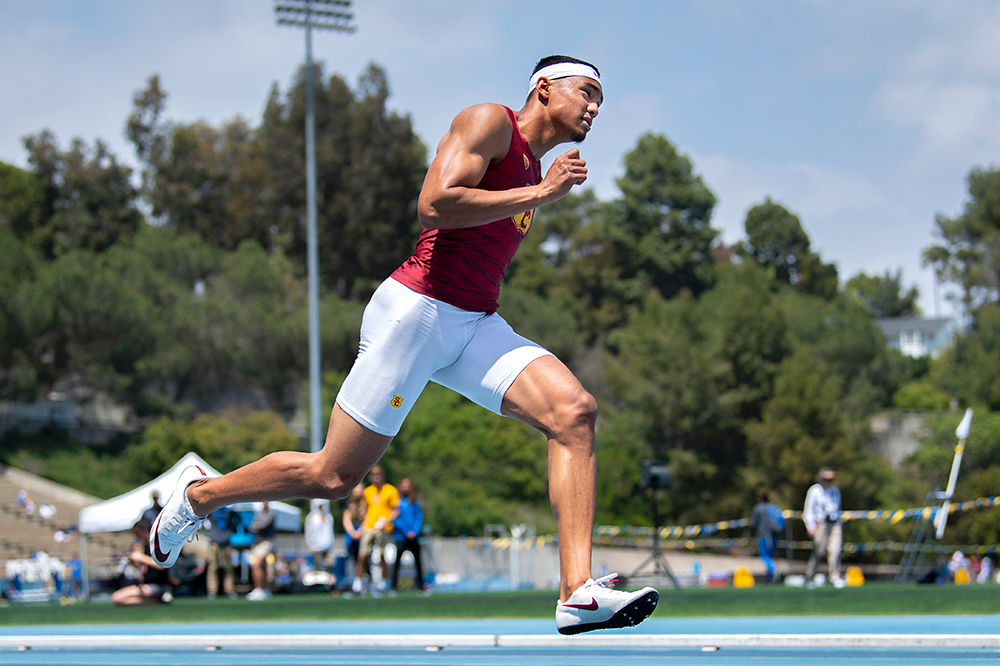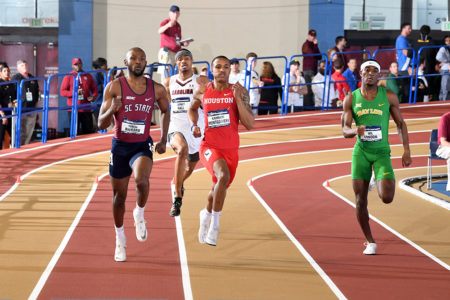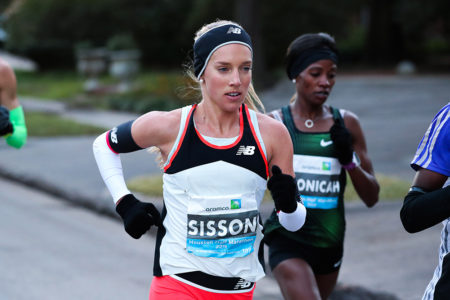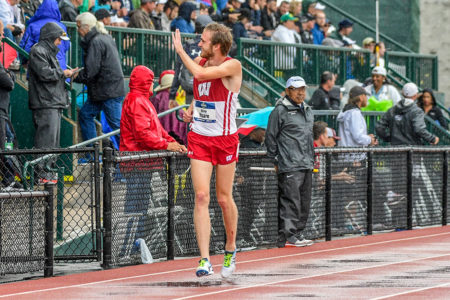
Note: This article was written and published in the T&FN newsfeed before the Mt. SAC Relays. We’ve opted to leave it in its “real-time” chronological spot.
ALTHOUGH THE LONG ’19 season is still in Coming Attractions mode, with most of us absorbed by the teasing trailers here and there, Michael Norman admits he’s ready to start the show. On Saturday at Mt. SAC, he’ll project the first few frames with his first 400 since he took the Collegiate Record down to 43.61 on a wet track at the NCAA last June.
Not that Norman is the restless type who’d throw his popcorn box at the screen to urge proceedings along. “Keeping the Dream Alive. PATIENCE PATIENCE PATIENCE PATIENCE PATIENCE PATIENCE PATIENCE PATIENCE PATIENCE PATIENCE PATIENCE PATIENCE PATIENCE IS A PROCESS l ?” is the motto on his Twitter feed.
Norman isn’t climbing the walls as he prepares for his first Nike-sponsored pro campaign; he’s just rarin’ to open with a lap against his training mate and fellow former Trojan Rai Benjamin and others in the meet where he cranked his ’18 outdoor 400 opener. All the holding fire, skipping the winter season—a contrast, indeed, to last year when he lowered the indoor CR to 44.52—hasn’t bothered Norman in the least. “Honestly, no,” he says when asked. “It feels more like high school and I kind of enjoy it more, to be honest. I’m not a fan of indoors and running early in the winter months. I really enjoy just training and running when I need to run. But, yeah, it feels just a lot like high school. Right now I’m getting a little antsy because it’s a lot longer of a wait, but I prefer this type of training to any other. I’d rather train longer and race less than race more and train less.”
What many will not know is that Norman did turn a circuit on a 4×4 at the Trojan Invitational a month ago. “Yeah, I ran a relay just for fun to break up training and just get an idea where we were. But I haven’t really ‘competed competed’ yet,” he says. Nonetheless, the split he got was 43.7. “So pretty OK shape right now,” he admits.
He has also been immersed in schoolwork. Norman, who turned 21 in December, would be a USC junior athletically were he competing collegiately this year, but on May 9 he’s set to graduate with a Communication degree after just 3 academic years in. “When I first came to school, my athletic director put me on a course to graduate in 3 years,” he says. “So since I’ve been at USC I’ve been taking 18 units plus summer school, and then one semester I had to take 20 units so I could graduate in 3. So it’s been nonstop work for me. Kind of hectic, a lot of paper writing. I think I’m going to go back and count how many papers I wrote, but I’m pretty sure I’m at least past 30. Probably in the 40s, to be honest.” In 3 weeks, he says, “I’ll be completely done with school finally and I’ll be able to focus more on track and other things in life.” He’s happy to be able to say it.
Norman’s agent, Emanuel Hudson of HSI, observes, “A lot of athletes would say, ‘I’ll defer graduation until after the Olympics. Not Michael. He’s doing it the other way. He wants school out of the way before the Olympic year. He likes to have a plan.”
Quincy Watts, himself the ’92 Olympic 400 gold medalist, coached Norman through his 2-year college career along with SC head Caryl Smith Gilbert and fellow assistant Joanna Hayes. They’re all still collaborating as his coaches (and Benjamin’s). “It’s a great characteristic to have that Mike is a planner,” Watts says. “Mike is not a procrastinator, he wants to do everything right and he wants to be sure he’s doing everything right. I think that is one of the great qualities that he has. I mean Mike is one of the most humble, nicest kids you ever want to meet. Seeing him in the practice arena or warming up with his teammates or his former teammates, you see Mike as just a kid. But when you get him in the other arena where it’s time to make business decisions and it’s time to make winning decisions and it’s time to focus, you’re going to see a different Michael. He’s a perfectionist and a lot of time Mike already knows the answer to the questions he’s asking you. He’s just testing you and also having great dialogue. It’s not that he’s testing in a bad way, it’s just having great dialogue and great communication because he wants to make sure he has it right.”
The Mt. SAC outing on Saturday will represent, more or less, an early-term quiz for Norman. “We’re just looking at Mt. SAC as an opportunity to break up training, we can see where we’re at,” Watts explains. “What that will do is give us some excitement coming back after Mt. SAC to train.” The training so far for the first-year pro has featured no radical breaks from Norman’s collegiate program—other than the adjusted timing as he points toward a hoped-for World Championships debut in October in Doha.
“I wouldn’t say I’m trying to develop anything new,” Norman says. “I think we’re fine-tuning some specific components of the race and how I run. At the beginning of fall training for us we kind of focus on relearning how to run, and to run properly, more efficiently. From there we kind of just focus on those changes, really emphasize them in practice. And then as we’re getting ready to compete now we’re really focusing on race pattern. So this year there’s certain pieces of the 400 that I have yet to master so we’re really focusing on those components of the race. Besides that, I think we’re also incorporating a little bit more speed this year. Last year we had a lot of modified practices. Coach Watts does a great job of adapting our workouts to fit our needs and keep us healthy, but this year as I’m developing and have grown stronger, we’re trying to implement more speed into the program. So I guess those are the only really major differences—in training at least. We do a lot of cross-training, as well.” (continues)
The coaching crew sees to it that Norman and Benjamin line up on the training track under specific circumstances. “At this point it’s probably about 75% of the time that we run together,” Norman says. “If it’s more of a tempo type workout where we have to hit specific times, we’ll definitely run in a group. But if we have a speed endurance or a maximum speed type workout, it’s like a 50-50 chance if we’re gonna run together or not. It kind of depends on how our bodies feel and what our coaches think is appropriate for what’s coming up. So we do line up a lot but we don’t always race at practice.”
Although the 400 is his wheelhouse race, a natural question is where the 200—in which he dashed 19.84 and then 19.88 on the DL Circuit last summer—fits into his schedule? “My main focus is the 400,” Norman explains, “but I really love to run the 200 just to work on the speed aspects of the 400. It’s just an enjoyable race and it’s just fun to show some versatility in the sport. Hopefully some day I’ll drop down to the 100. I have to convince coach. But other than that, I really love the event, to be honest. It’s a lot of fun, it breaks up training. You can’t always just run 400s every meet the whole year. I think it’s essential to get those shorter, more fast races in—especially earlier in the season.”
This year Norman’s first 200 will go down, per the plan, at the Osaka IWC on May 19. His mother, Nobue, was born and grew up in Japan, and was an accomplished high school sprinter in that country. The Osaka trip will be her son’s first visit to the Land of the Rising Sun. “My Mom’s actually going to fly out there, visit some family, and then she’s going to meet me in Osaka, watch me run and then go back to her family for a couple more weeks, and then head back home,” Norman says. He expects to meet his grandfather for the first time. Propitious timing for a grandson who has his eyes on the Tokyo Olympics.
Norman’s track exploits have not gone unnoticed by the Japanese media, members of which have showed up in SoCal to interview him and his parents already this year. “They’ve just shown a lot of interest and I really appreciate it because, being half Japanese, I think it’s important to show respect for my Mom’s side and the people of Japan just to show that although I represent the U.S. for competition, I still represent them through my nationality,” Norman says.
It’s far too early in the season for Norman to talk about time goals as he prepares to step up for his first race of the year, but he’s willing and able to speak with a longer-term perspective. “I’m really focusing on winning and executing the race perfectly,” he says. “But if I were to put a time on it, I know I would love to be the first person to run 42. I think that’s one of my biggest goals coming into these next two years. If it’s not going to happen this year, it’s definitely going to happen next year, if it’s me or somebody else.
“I think the 400 field is so strong and it continues to develop so there’s a lot of great talent out there to kind of elevate each other to the next level. I’m assuming the World Record is going to fall within the next two years. If not this year, definitely at the Olympics, I believe.”
Coach Watts, too, looks towards Saturday’s dip into competition through a long lens: “One of the things that we do well and coach Caryl does well is our periodization for the season. We will map out our goals and where we want to be for USAs because that’s our No. 1 priority, making the team. So the No. 1 priority is being ready and being fit to make the team. After that, we know how to manage it as well so we don’t necessarily get too caught up with that. Coach Caryl is a master at doing periodization so we’ll run well and then go back down under and train, then come back out and we’ll run well again.
“When I say ‘go back down under,’ I mean we’ll make our load heavy. When it comes time to compete we may lighten the load a little bit. And a lot of times when we’re competing, even at Mt. SAC, we’re competing but we’re heavy-loaded with our legs. One of the things that we cannot do is not compete. We have to go ahead and compete and be satisfied with our performance. And if we need to make corrections, we will. As we go into any competition we’re going to make sure that we understand what our goal is going in, whether it’s to run fast or we don’t really care about how fast we run but we just want to go win.”






